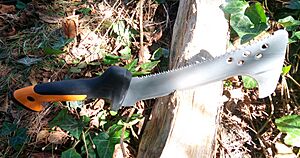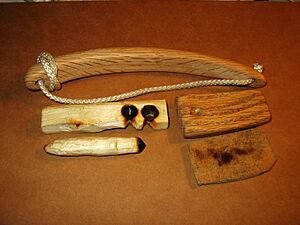Bushcraft facts for kids
Bushcraft is all about learning and using skills to live well in nature. It teaches you how to find what you need and be comfortable in the wild. Bushcraft skills include finding food, hunting, fishing, making fire, and tying knots.
Sometimes, people use the word Woodcraft. This is a part of bushcraft that focuses on skills for living in forests or woodlands. Fieldcraft is a similar set of skills, but it's often used by the military.
Contents
Bushcraft Skills
Bushcraft skills help you get the basic things humans need to survive. These include finding food, getting clean water, building shelters, and making fire.
Food and Water
You can find food by foraging (looking for edible plants), tracking animals, hunting, trapping, or fishing. Learning how to find and clean water is also very important. This is called water purification.
Shelter and Fire
Building a safe place to sleep, called a shelter, is a key skill. Making fire, or firecraft, is also essential for warmth, cooking, and safety.
Tools and Other Skills
Bushcraft also involves using tools like special knives and axes. With these tools, a skilled person can make many things. This could be anything from a dugout canoe to a simple A-frame shelter.
Besides these, you might learn how to make twine (rope), tie different knots, carve wood, and set up a camp. Knowing about natural navigation (finding your way using nature) and making simple tools or weapons are also part of bushcraft.
Shelter Types
While camping, people often use tents. You can also make a temporary tent from a large tarp or blanket. Some shelters are made from natural materials, like a snow cave or a bark lean-to. Natural places like caves or thick bushes can also serve as shelters.
Important Knots
Tying knots is a very useful bushcraft skill. Here are some common knots and what they are used for:
- The reef knot (also called a square knot) is good for tying things together, like bandages or bundles. You can pull the rope tight as you tie it.
- The figure-8 loop makes a loop that won't get tighter. It's useful for attaching a hook to a fishing line or for lifting heavy items.
- The improved clinch knot is often used to attach a hook to a fishing line or to tie something to a pole or tree.
- The clove hitch is great for starting to tie things together, like when building a raft or attaching a shelter to a tree.
- The snare noose is sometimes used to catch small animals. It's a loop that tightens around an animal's neck.
Where the Word Comes From
The word bushcraft first described skills used in the Australian bush. People in Australia and South Africa have used this word since the 1800s. The word bush likely came from the Dutch word bosch (now bos). This word meant woodland or natural areas. Later, it was used in British colonies to mean wild, undeveloped land, away from towns.
In Southern Africa, the word Bushman came from the Dutch boschjesman. This was used for native people living in the bush. In North America, the word bushwacker is similar to the Dutch bosch-wachter (now boswachter), meaning "forest-keeper."
Many books from the past have used the term bushcraft:
- The Art of Travel by Francis Galton, published in 1854.
- The History of Australian Exploration from 1788 to 1888 by Ernest Favenc, published in 1888.
- My Brilliant Career by Miles Franklin, published in 1901.
- Campaign Pictures of the War in South Africa (1899–1900) by A. G. Hales, published in 1901.
- The Explorers of Australia and their Life-work by Ernest Favenc, published in 1908.
- We of the Never-Never by Jeannie Gunn, published in 1908.
- The Life of Captain Matthew Flinders by Ernest Scott, published in 1914.
The term became more widely known in the Southern Hemisphere because of Les Hiddins, also known as the Bush Tucker Man. In the Northern Hemisphere, Mors Kochanski helped make it popular. More recently, in the United Kingdom, Ray Mears made bushcraft famous through his TV shows.
People Who Promote Bushcraft
Richard Graves, an Australian writer born in Ireland, wrote "The 10 bushcraft books." These were outdoor manuals.
Mors Kochanski, a wilderness instructor from Canada, published his book "Northern Bushcraft" in 1981. He later released an updated version in 1988. He has said that his book title was a direct nod to Graves' work.
Many people have helped make bushcraft popular today. These include Ray Mears, Cody Lundin, Les Hiddins, Les Stroud, Dave Canterbury, and Mors Kochanski. They have all had popular television programs about bushcraft and survival.
See also
 In Spanish: Bushcraft para niños
In Spanish: Bushcraft para niños
- Batoning
- Outdoor education
- Scoutcraft
- Survivalism
- Czech tramping
People
- Bradford Angier
- Dick Proenneke
- Horace Kephart
- Jamie Maslin
- Lofty Wiseman




